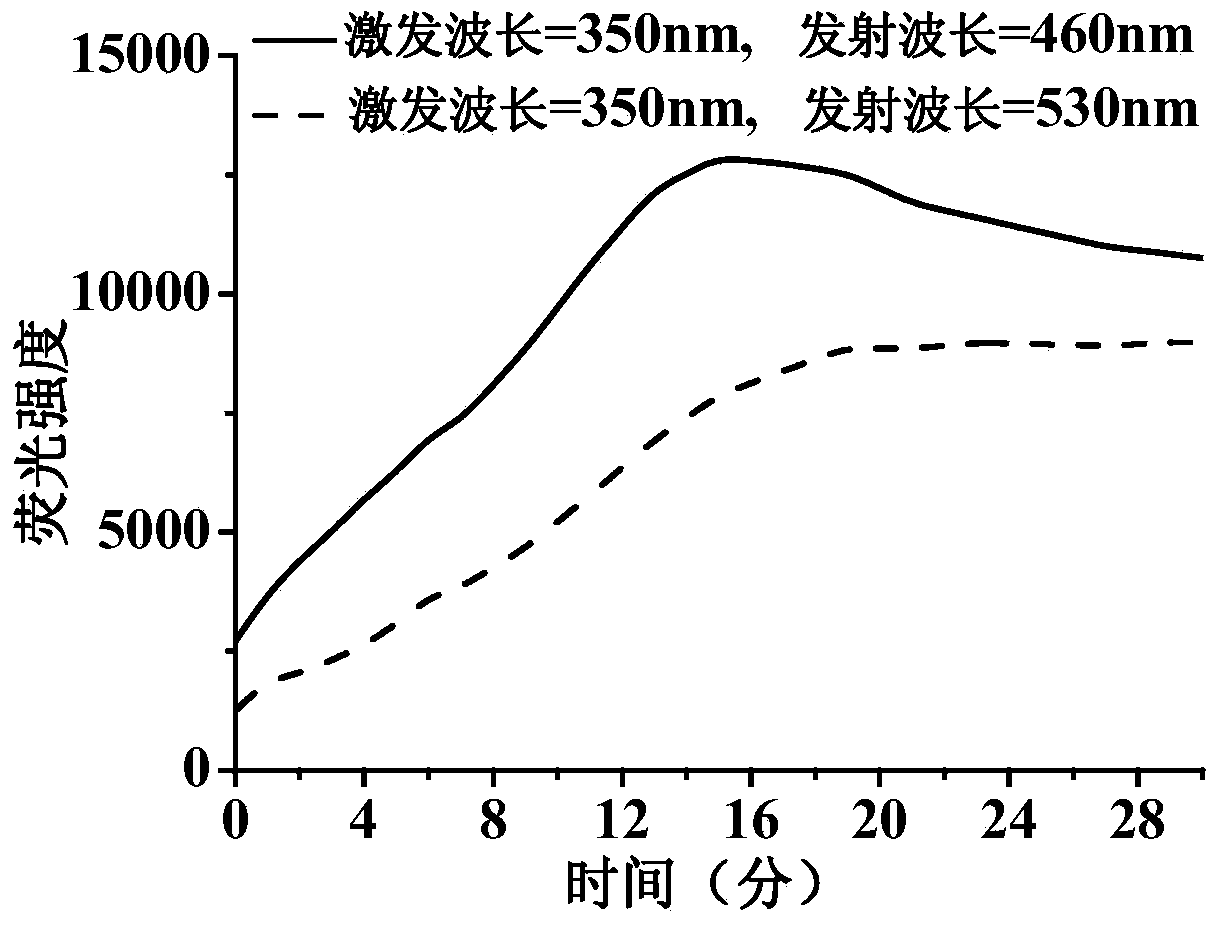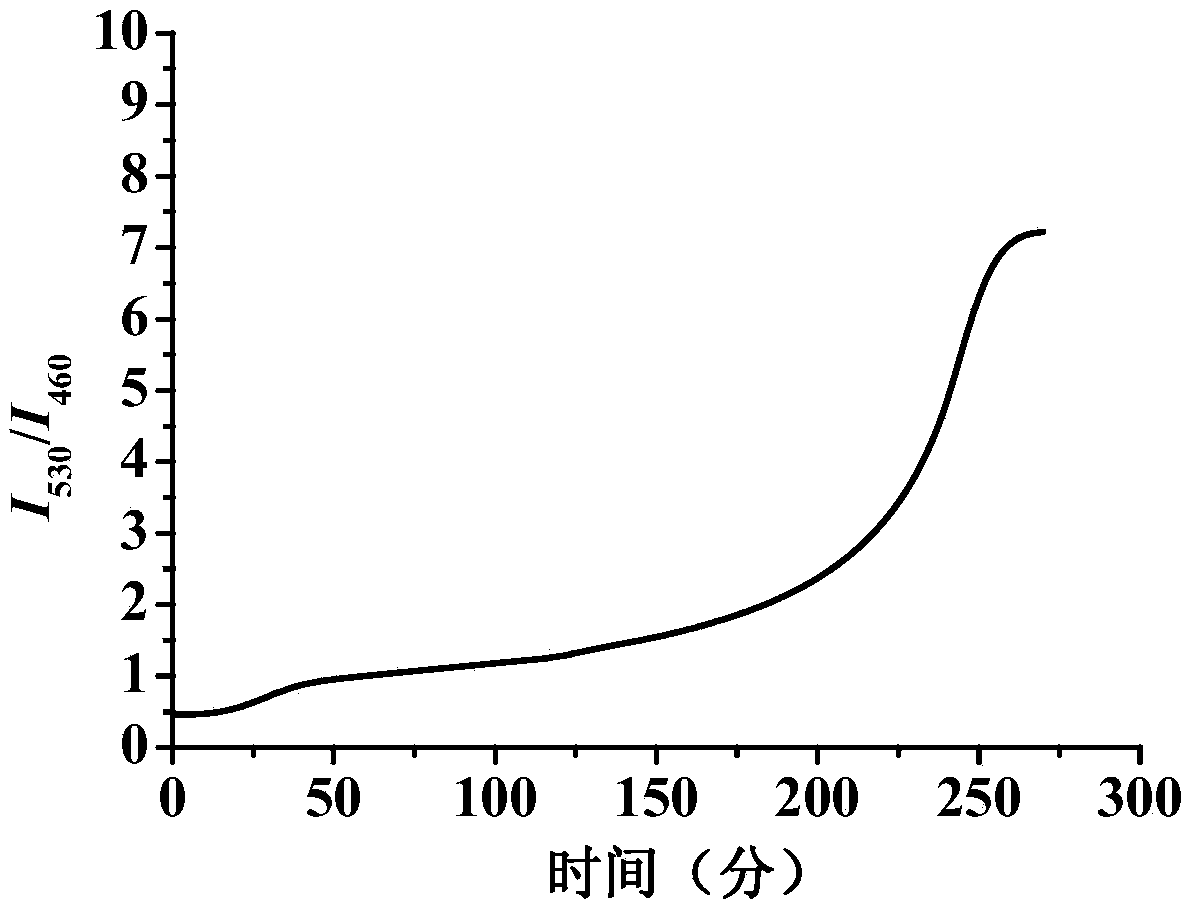A compound and an alkaline phosphatase activity fluorescence detection method adopting the compound
A phosphatase activity and compound technology, applied in the field of new compounds, can solve the problems of high background and non-specific binding, and achieve the effect of improving accuracy and sensitivity
- Summary
- Abstract
- Description
- Claims
- Application Information
AI Technical Summary
Problems solved by technology
Method used
Image
Examples
Embodiment 1
[0044] Example 1: Preparation of 2-(3,6-diphosphoryloxy-9H-oxanthene-9-yl)-4(5)-((4-(1,2-diphenyl-2-(p Tolyl) vinyl) benzyl) carbamoyl) benzoic acid
[0045]
[0046] Firstly, methyl benzophenone (1.96g, 10mmol) and zinc powder (1.95g, 30mmol) were added into a dry three-necked flask, a magnet was put into it, and then it was evacuated, followed by nitrogen gas. Use a syringe to pipette the newly distilled THF solution (50 mL) into a three-necked flask, and stir the solution, and the solution becomes a gray suspension at this time. Pipette (1.7mL, 15mmol) TiCl with a syringe 4 , and gradually added dropwise to the three-neck flask at -60°C, with the TiCl 4 The solution reacted violently, and a yellow solid appeared on the wall of the flask. After the dropwise addition, it reacted at room temperature, and the color of the solution became bright black. Then, the temperature of the oil bath was raised to 78° C. and refluxed overnight. After the reaction was completed, the m...
Embodiment 2
[0054] Embodiment 2: Real-time detection of alkaline phosphatase activity by FRET fluorescent probe:
[0055] Dissolve the sample of alkaline phosphatase activity to be tested in a microcentrifuge tube with a concentration of 50 mM and a boric acid buffer solution with a pH value of 8.4 to obtain a sample solution (22.5 mg / mL) of alkaline phosphatase activity to be tested, and take 20 μL to be tested The sample solution of alkaline phosphatase activity was put into 278 μL of 50 mM pH8.4 boric acid buffer, and 2 μL of the compound (i) prepared in Example 1 was added with a concentration of 7.5 mM. The final concentration of the fluorescent probe in the reaction solution was 50 μM. Use a microplate reader to immediately detect the fluorescence intensity in the sieve plate, and analyze the relationship between the fluorescence intensity and time as follows: figure 1 , figure 2 shown.
[0056] Experiments have shown that the fluorescence intensity increases gradually with the p...
Embodiment 3
[0057] Embodiment 3: FRET fluorescent probe concentration is to the detection of alkaline phosphatase activity:
[0058] In order to obtain the effect of probe concentration on the detection results, a set of gradient experiments was designed according to the application model of fluorescent probes, and three parallel experimental groups were taken. Add an appropriate amount of boric acid buffer solution (concentration 50mM, pH=8.4) in a microcentrifuge tube, and then add 20 μL of enzyme solution (alkaline phosphatase sample is dissolved in a boric acid buffer solution with a concentration of 50 mM and a pH value of 8.4 to obtain a concentration of 22.5 mg / mL enzyme solution), and finally add an appropriate amount of probe to make the final concentration of 0μM, 25μM, 50μM, 75μM, 100μM, 150μM, 200μM, take 200μL after 2h of reaction and record the experimental data with a fluorescent microplate reader, λ ex / λ em = 350 / 530nm.
[0059] The effect of probe concentration on the...
PUM
 Login to View More
Login to View More Abstract
Description
Claims
Application Information
 Login to View More
Login to View More - R&D
- Intellectual Property
- Life Sciences
- Materials
- Tech Scout
- Unparalleled Data Quality
- Higher Quality Content
- 60% Fewer Hallucinations
Browse by: Latest US Patents, China's latest patents, Technical Efficacy Thesaurus, Application Domain, Technology Topic, Popular Technical Reports.
© 2025 PatSnap. All rights reserved.Legal|Privacy policy|Modern Slavery Act Transparency Statement|Sitemap|About US| Contact US: help@patsnap.com



